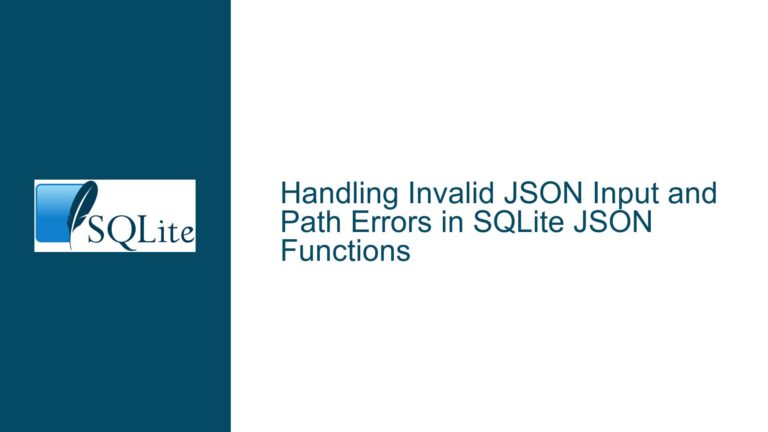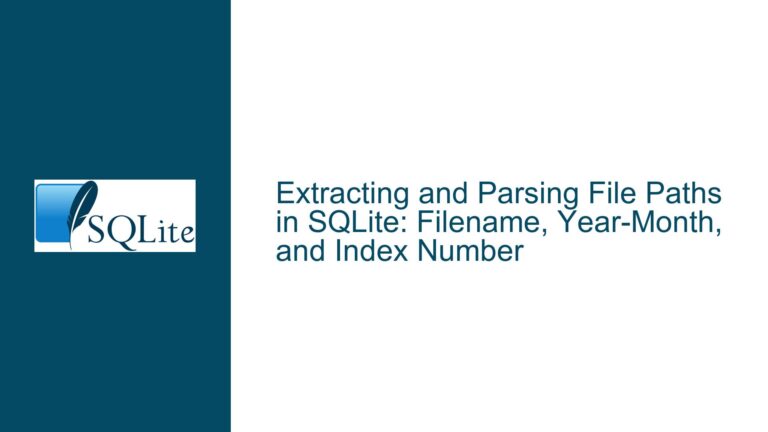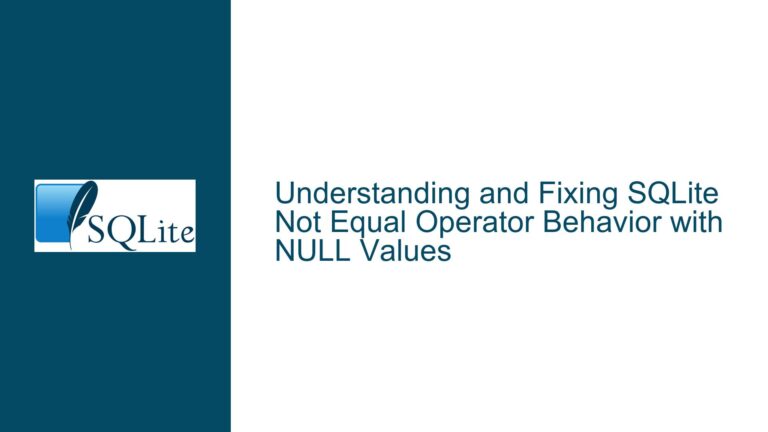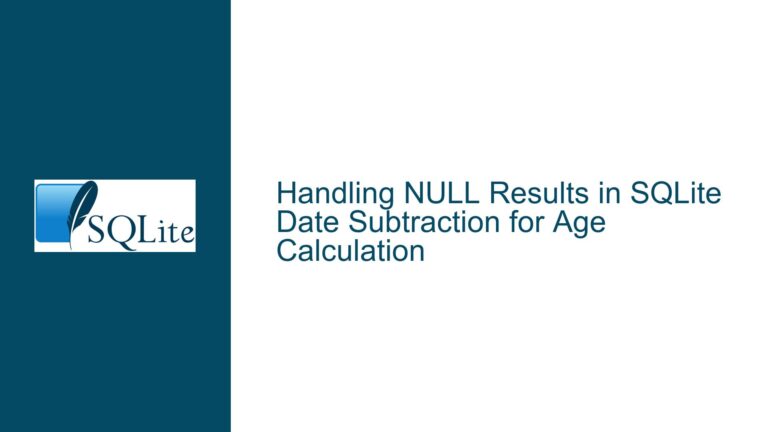VACUUM INTO Behavior with PRAGMA query_only=1 in SQLite
Issue Overview: VACUUM INTO Fails with PRAGMA query_only=1
When working with SQLite, the VACUUM INTO command is a powerful tool for creating a backup of a database by writing the contents of the current database into a new file. However, users may encounter an unexpected error when attempting to use VACUUM INTO while the PRAGMA query_only=1 setting is enabled. The error message, "Error: attempt to write a readonly database," suggests that the operation is being blocked due to the database being in a read-only state. This behavior can be confusing, especially since the documentation for VACUUM INTO implies that it is not a write operation in the same sense as other commands like INSERT or UPDATE.
The confusion arises from the interaction between PRAGMA query_only=1 and the internal mechanics of the VACUUM INTO command. While PRAGMA query_only=1 is designed to prevent modifications to the database, it also affects operations that involve creating or writing to new database files, such as VACUUM INTO. This is because VACUUM INTO inherently involves writing data to a new file, even though it does not modify the original database. Understanding this interaction requires a deeper dive into how PRAGMA query_only=1 and VACUUM INTO work individually and in combination.
Possible Causes: Why VACUUM INTO Fails Under PRAGMA query_only=1
The failure of VACUUM INTO when PRAGMA query_only=1 is enabled can be attributed to several underlying factors related to SQLite’s internal mechanisms and the design of these two features.
1. PRAGMA query_only=1 and Its Scope
The PRAGMA query_only=1 setting is designed to enforce a read-only mode on the database connection. When enabled, it prevents any operations that would modify the database, such as CREATE, DELETE, DROP, INSERT, or UPDATE. However, the documentation clarifies that the database is not truly read-only in the sense of being immutable; rather, the pragma acts as a safeguard to prevent accidental modifications. This means that while the database file itself may still be writable, the connection will reject any operation that attempts to alter its contents.
The scope of PRAGMA query_only=1 extends to all databases associated with the connection, including the main database, the temp database, and any attached databases. This comprehensive coverage ensures that no part of the connection can be used to modify data, even if multiple databases are involved.
2. VACUUM INTO and Its Internal Workflow
The VACUUM INTO command is used to create a new database file containing a compacted and optimized copy of the current database. Unlike the standard VACUUM command, which rewrites the database in place, VACUUM INTO writes the output to a separate file. This distinction is important because it means that VACUUM INTO does not modify the original database file. However, the process of creating and writing to a new file is still considered a write operation from the perspective of the database connection.
Internally, VACUUM INTO involves several steps:
- Creating a new database file at the specified location.
- Attaching the new file to the current database connection.
- Copying the schema and data from the original database to the new file.
- Detaching the new file and finalizing the operation.
Each of these steps requires write permissions, even though the original database remains unchanged. This is where the conflict with PRAGMA query_only=1 arises.
3. Interaction Between PRAGMA query_only=1 and VACUUM INTO
When PRAGMA query_only=1 is enabled, the database connection is configured to reject any operation that involves writing data. This includes operations that create or modify files, such as VACUUM INTO. Even though VACUUM INTO does not alter the original database, it still requires the ability to create and write to a new file. Since PRAGMA query_only=1 prevents any form of writing, the operation is blocked, resulting in the "attempt to write a readonly database" error.
The key takeaway is that PRAGMA query_only=1 is not limited to preventing modifications to the existing database; it also restricts operations that involve creating or writing to new files. This behavior is consistent with the pragma’s purpose of ensuring that the database connection remains in a read-only state.
Troubleshooting Steps, Solutions & Fixes: Resolving the VACUUM INTO Error
To address the issue of VACUUM INTO failing under PRAGMA query_only=1, several approaches can be taken. These range from understanding the limitations of the pragma to implementing alternative methods for creating database backups.
1. Disabling PRAGMA query_only=1 Temporarily
The simplest solution is to disable PRAGMA query_only=1 before running the VACUUM INTO command. This can be done by setting PRAGMA query_only=0 before executing VACUUM INTO and then re-enabling it afterward. This approach allows the VACUUM INTO operation to proceed while maintaining the read-only state for other operations.
Example:
PRAGMA query_only=0;
VACUUM INTO 'backup.db';
PRAGMA query_only=1;
This method ensures that the database remains in a read-only state for the majority of operations while temporarily allowing the necessary write permissions for the backup process.
2. Using Alternative Backup Methods
If disabling PRAGMA query_only=1 is not feasible, alternative methods for creating database backups can be employed. One such method is using the .backup command in the SQLite command-line interface (CLI). This command creates a backup of the database without requiring write permissions on the original database file.
Example:
.backup 'backup.db'
The .backup command is specifically designed for creating backups and does not conflict with PRAGMA query_only=1. It works by copying the contents of the database to a new file, similar to VACUUM INTO, but without the need for write permissions.
3. Understanding the Limitations of PRAGMA query_only=1
It is important to recognize that PRAGMA query_only=1 is not a foolproof mechanism for enforcing a read-only state. While it prevents most forms of modification, it does not guarantee that the database file itself is immutable. For example, the file can still be modified by external processes or by using a different database connection.
To achieve a truly read-only state, the database file should be set to read-only at the filesystem level. This can be done by changing the file permissions or using operating system features to lock the file. Once the file is read-only at the filesystem level, PRAGMA query_only=1 becomes redundant, as the database cannot be modified regardless of the pragma setting.
4. Evaluating the Use Case for PRAGMA query_only=1
In some cases, the use of PRAGMA query_only=1 may not be necessary or appropriate. For example, if the primary goal is to prevent accidental modifications, other mechanisms such as transaction control or user permissions may be more effective. By carefully evaluating the use case, it may be possible to avoid the conflict between PRAGMA query_only=1 and VACUUM INTO altogether.
5. Modifying the Application Workflow
If the application workflow requires frequent use of VACUUM INTO and PRAGMA query_only=1, it may be necessary to modify the workflow to accommodate both features. This could involve separating the backup process from other database operations or using a dedicated database connection for backups. By isolating the backup process, it becomes possible to disable PRAGMA query_only=1 for the duration of the backup without affecting other operations.
Example:
-- Main connection (read-only)
PRAGMA query_only=1;
-- Perform read-only operations
-- Backup connection (write-enabled)
PRAGMA query_only=0;
VACUUM INTO 'backup.db';
This approach ensures that the main database connection remains in a read-only state while allowing the backup process to proceed without errors.
In conclusion, the issue of VACUUM INTO failing under PRAGMA query_only=1 is a result of the interaction between the read-only enforcement of the pragma and the write requirements of the VACUUM INTO command. By understanding the underlying causes and implementing appropriate solutions, it is possible to resolve the error and achieve the desired outcome. Whether through temporary disabling of the pragma, alternative backup methods, or workflow modifications, there are multiple ways to address this issue while maintaining the integrity and security of the database.






